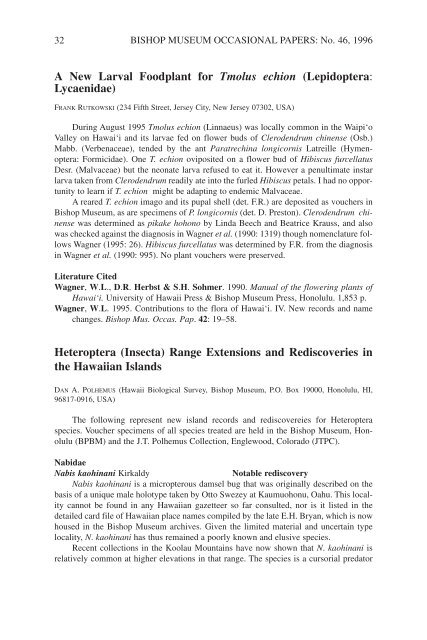Notes - Hawaii Biological Survey - Bishop Museum
Notes - Hawaii Biological Survey - Bishop Museum
Notes - Hawaii Biological Survey - Bishop Museum
You also want an ePaper? Increase the reach of your titles
YUMPU automatically turns print PDFs into web optimized ePapers that Google loves.
32<br />
BISHOP MUSEUM OCCASIONAL PAPERS: No. 46, 1996<br />
A New Larval Foodplant for Tmolus echion (Lepidoptera:<br />
Lycaenidae)<br />
FRANK RUTKOWSKI (234 Fifth Street, Jersey City, New Jersey 07302, USA)<br />
During August 1995 Tmolus echion (Linnaeus) was locally common in the Waipi‘o<br />
Valley on Hawai‘i and its larvae fed on flower buds of Clerodendrum chinense (Osb.)<br />
Mabb. (Verbenaceae), tended by the ant Paratrechina longicornis Latreille (Hymenoptera:<br />
Formicidae). One T. echion oviposited on a flower bud of Hibiscus furcellatus<br />
Desr. (Malvaceae) but the neonate larva refused to eat it. However a penultimate instar<br />
larva taken from Clerodendrum readily ate into the furled Hibiscus petals. I had no opportunity<br />
to learn if T. echion might be adapting to endemic Malvaceae.<br />
A reared T. echion imago and its pupal shell (det. F.R.) are deposited as vouchers in<br />
<strong>Bishop</strong> <strong>Museum</strong>, as are specimens of P. longicornis (det. D. Preston). Clerodendrum chinense<br />
was determined as pikake hohono by Linda Beech and Beatrice Krauss, and also<br />
was checked against the diagnosis in Wagner et al. (1990: 1319) though nomenclature follows<br />
Wagner (1995: 26). Hibiscus furcellatus was determined by F.R. from the diagnosis<br />
in Wagner et al. (1990: 995). No plant vouchers were preserved.<br />
Literature Cited<br />
Wagner, W.L., D.R. Herbst & S.H. Sohmer. 1990. Manual of the flowering plants of<br />
Hawai‘i. University of <strong>Hawaii</strong> Press & <strong>Bishop</strong> <strong>Museum</strong> Press, Honolulu. 1,853 p.<br />
Wagner, W.L. 1995. Contributions to the flora of Hawai‘i. IV. New records and name<br />
changes. <strong>Bishop</strong> Mus. Occas. Pap. 42: 19–58.<br />
Heteroptera (Insecta) Range Extensions and Rediscoveries in<br />
the <strong>Hawaii</strong>an Islands<br />
DAN A. POLHEMUS (<strong>Hawaii</strong> <strong>Biological</strong> <strong>Survey</strong>, <strong>Bishop</strong> <strong>Museum</strong>, P.O. Box 19000, Honolulu, HI,<br />
96817-0916, USA)<br />
The following represent new island records and rediscovereies for Heteroptera<br />
species. Voucher specimens of all species treated are held in the <strong>Bishop</strong> <strong>Museum</strong>, Honolulu<br />
(BPBM) and the J.T. Polhemus Collection, Englewood, Colorado (JTPC).<br />
Nabidae<br />
Nabis kaohinani Kirkaldy<br />
Notable rediscovery<br />
Nabis kaohinani is a micropterous damsel bug that was originally described on the<br />
basis of a unique male holotype taken by Otto Swezey at Kaumuohonu, Oahu. This locality<br />
cannot be found in any <strong>Hawaii</strong>an gazetteer so far consulted, nor is it listed in the<br />
detailed card file of <strong>Hawaii</strong>an place names compiled by the late E.H. Bryan, which is now<br />
housed in the <strong>Bishop</strong> <strong>Museum</strong> archives. Given the limited material and uncertain type<br />
locality, N. kaohinani has thus remained a poorly known and elusive species.<br />
Recent collections in the Koolau Mountains have now shown that N. kaohinani is<br />
relatively common at higher elevations in that range. The species is a cursorial predator
















